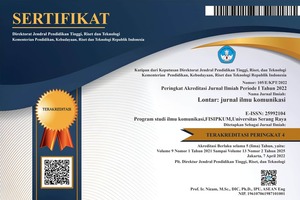The Impact of Internal Bulletins on Information Needs in Balai Besar Wilayah Sungai Brantas
DOI:
https://doi.org/10.30656/lontar.v11i1.6491Keywords:
Employees, Internal Media, Bulletin, Information NeedsAbstract
Mass communication is undoubtedly constructive for humans to meet their information needs individually and in groups. Communication is essential in human life as a process of delivering messages. It is the most basic need that is closely related to the continuity and defense of the existence of an organization or company. One of the roles in helping to establish effective communication relationships with the use of internal media has also been carried out by the Brantas. Using internal media implemented by the Brantas can establish relationships between internal and external stakeholders and assist in synchronizing information. The purpose was to determine the use of internal bulletins by employees in meeting internal information needs, to determine the fulfillment of internal information needs obtained by employees from internal bulletins as a source of information, and to determine the effect of using internal bulletins to meet the internal information needs of employees at Balai Besar Sungai Brantas. The result is that it was found that there was a relationship between the use of the Brantas Bulletin to meet their needs and the use of internal media could be used by an organization or agency.
References
Abdullah, A. (2016). Pengertian Media Internal. Retrieved 06 19, 2022, from digilab uinsgd: http://digilib.uinsgd.ac.id/25223/4/4_BAB%201.pdf
Asyhari, A., & Silvia, H. (2016). Pengembangan Media Pembelajaran Berupa Buletin dalam Bentuk Buku Saku untuk Pembelajaran IPA Terpadu. Ilmiah Pendidikan Fisika Al-Biruni, 1-13.Effendy, O. U. (2003). Ilmu, Teori dan Filsafat Komunikasi. Bandung: PT. Citra Aditya Bakti.
Effendy, O. U. (2003). Ilmu, Teori dan Filsafat Komunikasi. Bandung: PT. Citra Aditya Bakti.
Halik, A. (2013). Komunikasi Massa. Makassar: Alauddin University Press.
Hasan, E. (2005). Komunikasi Pemerintahan. Jakarta: PT. Rafika Aditama.
Ibrahim, A. I., Erdiyana, L. K., & Nugraha, A. R. (2021). Implementasi Corporate Social Responsibility PT. Pertamina (Persero) pada Program Siswa Mengenal Nusantara. LONTAR: Jurnal Ilmu Komunikasi, 9(2), 85-96.
Jefkins, F. (2005). Public Relations. Jakarta: Erlangga.
Jokhanan Kristiyono, S. T. (2020). KOMUNIKASI GRAFIS: Dilengkapi Panduan Teknis Desain Layout dengan Aplikasi Software Grafis InDesign. Prenada Media.
Kristiyono, J., & Ida, R. (2021). Identitas digital: Konstruksi identitas pada pameran karya seni Biennale Jawa Timur 8. Satwika: Kajian Ilmu Budaya dan Perubahan Sosial, 5(2).
Kristiyono, J., Patriagama, M. R., Atma, A., Septyan, I., Hanafi, R., & Asrori, H. S. (2021). Pengembangan Digital Branding Kampung Hidropononik Medokan Ayu Surabaya. Prapanca: Jurnal Abdimas, 1(1), 46-59.
Kristiyono, J., Permatasari, D. B. A., Ekantoro, J., & Roosinda, F. W. (2022). Digital educative public message: Health protocol awareness at pandemic COVID-19 periods (Instagram feeds@ humasprovjatim) Pesan edukasi digital kepada publik tentang kesadaran protokol kesehatan pada masa pandemi COVID-19 di Instagram feeds@ humasprovjatim. Masyarakat, Kebudayaan dan Politik, 35(3), 380-395.
Kurniawan, J. R. (2017). Pengelolaan Media Internal dalam Menjalin Hubungan dengan Publik Internal (Karyawan) di PT Kereta Api Indonesia DAOP VI Yogyakarta. Yogyakarta: Universitas Islam Indonesia.
Lani, O. P., & Handayani, B. (2021). Peranan Humas Pemerintahan (Government Public Relations) dalam Menciptakan Reputasi Pemerintahan yang Baik. LONTAR: Jurnal Ilmu Komunikasi, 9(2), 130-140.
Nur, E. (2021). Peran Media Massa dalam Menghadapi Serbuan Media Online. Majahal Ilmiah Semi Populer Komunikasi Massa, 51.
Pendit, P. L. (2003). Penelitian Ilmu Perpustakaan dalam Informasi Suatu Pengantar Diskusi Epistemologi dan Matadologi. Jakarta: JPFSUL.
Ruslan, R. (2005). Kiat dan Strategi Kampanye Public Relations. Jakarta: PT. Raja Grafindo.
Santoso, B. (2008). Implementasi Komunikasi Organisasi Internal di Redaksi Majalah Fahma Yogyakarta. Yogyakarta: Universitas Islam Negeri Sunan Kalijaga.
Soetiminah. (1992). Perpustakaan Kepustakawan dan Pustakawan. Yogyakarta: Kanisius.
Vivian, John. (2008). Teori Komunikasi Massa. Jakarta: Kencana.
Wursanto, I. (2001). Ilmu Komunikasi Teori dan praktek. Yogyakarta: Kanisius.
Yusuf, P. M. (2004). Teori dan Praktis Penelusuran Informasi: Informasi Retrieval. Jakarta: Prenda Media Group.
Downloads
Published
Issue
Section
License
By submitting an article to the journal, the author(s) agree to transfer the published article's copyright to the journal, which will act as the publisher. This means the journal will have the right to publish the article in various forms, including reprints. The journal will maintain the publishing rights to the published articles.
In line with the license, authors and third parties (readers, researchers, and others) are allowed to share and adapt the material. In addition, the material must be given appropriate credit, provided with a link to the license, and indicated if changes were made. If authors remix, transform, or build upon the material, authors must distribute their contributions under the same license as the original.





